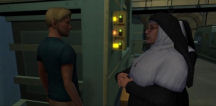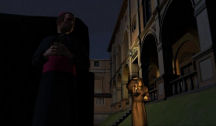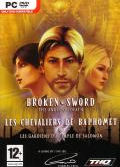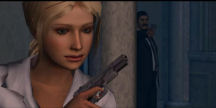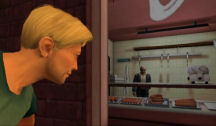What is it?
Broken Sword: The Angel
of Death is the fourth Broken Sword game, all of
which have been designed by Charles Cecil, luminary of many classic games,
of which the Broken Sword series forms only part. Of course, George
Stobbart is still the main protagonist, though this time he has a new
flame, Anna Maria. What of Nico Collard? Well, without wanting to actually
spoil the story, she does have her part to play, and itís not
insignificant.
Is
there a plot?
Itís a Broken Sword game, so
letís take a guess. What do you expect the plot to be about? The Aztecs?
Hi-tech space exploration? Egyptian PharaohsÖclose. Nope, itís The Knights
Templar of course.
Okay, a little more detail:
George is down on his luck Ė heís running a bail bond agency in a really
seedy part of New York. An unusually attractive young client arrives
desperate for his help, but not in making bail for some disreputable
brother or other, but in tracking down some stolen property. At which
point the Mafia gets involved, and George and Anna Maria (said young
client) are immediately on the run. Their travels take them back and forth
across the Atlantic, and finish in Rome, where a grand conspiracy,
revolving around the history and persecution of the aforementioned Knights
Templar, reaches its potentially fatal climax.
How
do you play?
This game marks a return to
conventional point-n-click after the keyboard controls of Broken Sword
3. The entire game can be played with a two-button mouse: left click
for walk and interact, right click for a menu of possible actions other
than the default one at a particular location. There are occasions where
the alternative keyboard controls are handy Ė moving George or Nico (when
itís her turn) around is easier for me that way. However, as us geeks are
fond of saying, ďÖyour mileage may vary.Ē
The inventory is in the form
of a scrolling ribbon across the top of the page, and you access it by
simply moving the mouse to the top of the screen. This is rather annoying
if you actually want to click on something towards the top of the screen,
as the inventory can obscure things. However, in terms of ease of access
when you actually want something from the inventory, it is one of the
easiest solutions Iíve come across.
Some inventory items can be
combined, though there are only a handful of times where this is required
to solve a puzzle. Left clicking an item will allow you to Ďuseí that item
with the next thing you click, be that another inventory item, or
something in the main scene.
The cursor has a couple of
different shapes which give you clues as to what things in the world can
be used -- though it was pleasing to find some things that were just there
for colour. The changes between cursor shapes are clear and swift, so
over-small hotspots are rare. Watch out for the fact that only the default
action will show up as you mouse around the screen, though; there are many
times when it is a good idea to check if a right click on a hotspot will
offer alternative actions.
The game is presented almost
entirely in 3D, and although you canít control the camera (your
view-point), the camera positions are well chosen, and the transitions
between cameras are generally smooth and well-placed. Itís hard to get
George out of your sight. Whether this is a good or bad thing, Iíll leave
you to decide.
Talking to the other
characters is an essential part of this game, and the conversation tree is
handled from a pop-up bar at the bottom of the screen. The obligatory (and
rather useful) subtitle option is available through the Options screen if
you have any difficulty with accented speech. Characters originate from
the USA, Italy, France, Ireland, Turkey, and the U.K., so a variety of
accents are to be expected. I must mention at this point that the voice
acting of all the characters was good throughout.
There are a number of places
in the story where the wrong choice will kill you. However, the game will
restart immediately from a point where it is possible to avoid said wrong
choice. With unlimited saves available at almost any point, having death
as an outcome to an action isnít much of an obstacle.
Notable Features
A minor feature in this
game, that I certainly appreciate, is the ability to access the full
Options screens (with the usual Video, Audio and Controls sub-screens)
from within the game itself. Pressing Esc will bring up the Resume, Save,
Load, Options and Exit screen. Even screen resolution changes can be made
without the game having to restart before taking effect. Furthermore, you
can switch the game from full screen to windowed mode at the same time,
though I found that windowed mode is somewhat more jerky than full screen,
even at a lower resolution.
These days, a commonplace
item in the adventure detectiveís armoury is the PDA (personal digital
assistant). In Georgeís case (and Nicoís when she borrows the device for a
period), the PDA is a phone, a notebook, a web browser and a network
hacking device. The game doesnít make much use of the phone, but the
notebook/browser and the hacking device are important tools. When George
or Nico need to access a secure computer system (there are several times
when this is necessary), they use a kind of mini-game where the object is
to get a light signal from a source to a destination using mirrors and
splitters, whilst avoiding traps and hard obstacles. Itís a game Iíve seen
out on the Internet thatís fun in its own right, and it adds a rewarding
logical challenge thatís novel in the context of a game. Other puzzle
types in the game include various combination locks, small mazes, stealth,
deception, and inventory puzzles.
Two particular sequences of
puzzles are based on parchments with clues on them. Thankfully it is
almost always easy to access the parchments to get at the clues, so youíre
not left thinking, ďOh, I wish Iíd written out what that parchment says in
my notes.Ē Actually, I found there was very little need for note taking at
all, as George acts largely as his own notebook. This is just as well,
because a down-side to the control mechanism of the two-button mouse is
that it doesnít really allow for much in the way of fine-grained choices
in actions. If you click on the safe, whatís the game to do? Lift it up?
Turn it around? Or should George climb on top of the safe? These are
made-up examples, and the game mostly counters this because you usually
know what George is going to do when you click on an object. However,
there are some surprises that I wonít detail, for fear of spoiling some
puzzles.
Any
other novelties?
Well, this bit is new to me:
I donít think Iíve ever come across a main character in a game that I
liked less than George Stobbart. Sorry folks. I know that a lot of people
think heís wonderful, but I didnít enjoy him at all. At turns smug, naÔve,
thick, and just plain insensitive. Nico, on the other hand, is sarcastic,
but more tag-along accessory than the wannabe Lara Croft pin-up that the
developers seem to want her to be. The only character I liked in the
entire game was Archie, the hobo in Rome! Everyone else was either a
clichť or a cardboard cutout.
Oddities
Given the overall technical
quality of this title, I was disappointed to experience a few crashes to
the desktop. This is not particularly bad over the many hours of play, but
still, itís a case of Ďcould do better.í
The most annoying feature of
Broken Sword: The Angel of Death was that there is no way to skip
long dialog lines. This may be all very well if youíre hearing a line for
the first time, but itís extremely annoying if you repeat a conversation,
or if youíre repeating a section on reloading a save game. Not to mention
how annoying it is to be a fast reader of subtitles and not be able to
make the actors keep up!
However, the biggest oddity
of all regarding this game is that the promotion of it by THQ appears to
have been low-key to say the least. Just a month after game launch, and
can I find mention of it on THQ's home-page? In the game finder? No. It
gets worse. Type Ďbroken swordí into the search box on their homepage and
the only game it brings up is...wait for itÖLego Knights' Kingdom!
No wonder people think adventure games often donít sell well, if the
publishers canít even be bothered to publicize them on their own website!
The developers, Sumo
Digital, and Revolution Games (Charles Cecilís people) are rather better
of course, and Revolution Games provide a helpful
hints page, where the answers to frequently asked questions are
revealed in stages.
Conclusion
This is the first Broken
Sword game Iíve played from end to end, though I did play Broken Sword
3 (The Sleeping Dragon) up until the turgid Glastonbury section.
Whilst I found that the puzzle solutions in Angel of Death were
more logical than in The Sleeping Dragon, I found that I was
struggling to find the will to complete the game towards the end. This was
mostly down to the seeming obsession in the plot with the attractiveness
of George to others. And as for Monatomic Gold and the Knights Templar?
Well, no more for me, thanks.
Finally, the grade. I donít
know. I really donít know. Would an A grade be appropriate? As far as I
am concerned, not having played the last three Broken Sword games
completely, this game is Ďjust another point-n-click adventure.í If it
werenít for George and Nico and the Broken Sword moniker, would the game
really get the coverage? I suspect not, because it is not, as an A grade
would suggest, groundbreaking nor a fascinating contribution to the genre.
Perhaps a B+ would be
appropriate Ė the game is professionally produced, with high production
values, a few nice features, but it is lacking the sparkle that marks say,
an A- (a top rate game with lots of new ideas, but some flaws), an A (no
flaws), or an A+ (a completely genre-redefining game, like The Longest
Journey).
So, this is a well-built
game, with very few technical issues. It kept me occupied for quite some
time without managing to frustrate me with completely impenetrable
puzzles, whilst at the same time, it simply failed to sparkle. Itís one I
wonít play again. I think Iíll go for the B+.
What
do you need to play it?
Minimum Requirements
●
Windows(R) XP
●
DirectX 9.0c
(included)
●
Pentium 4 1.4GHz
(or better)
●
256 MB RAM (512MB
recommended)
●
2.6 GB free hard
drive space
●
2x DVD-ROM Drive
●
DirectX 9.0
compatible 128 MB Shader model 1.1 compatible video card
●
DirectX 9.0
compatible Windows compatible sound card
●
Keyboard, Mouse
(I used a custom built Win XP Pro SP2, AMD Athlon 64
3500+, 1024 MB RAM, and nVidia GeForce 6600GT 256MB)
10-2006
design copyright ©
2006
GameBoomers
Group
